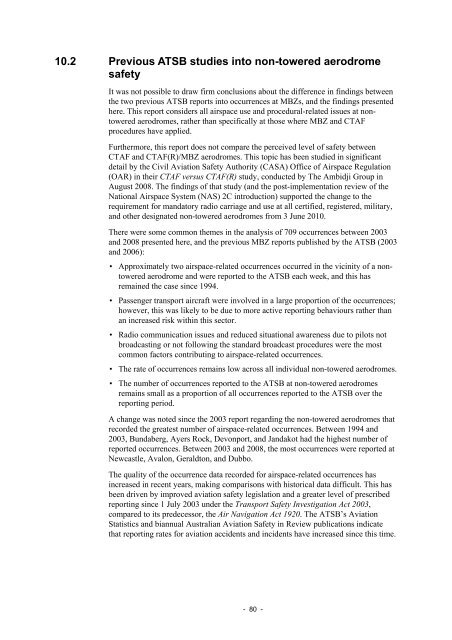Safety in the vicinity of non-towered aerodromes - Australian ...
Safety in the vicinity of non-towered aerodromes - Australian ...
Safety in the vicinity of non-towered aerodromes - Australian ...
Create successful ePaper yourself
Turn your PDF publications into a flip-book with our unique Google optimized e-Paper software.
10.2 Previous ATSB studies <strong>in</strong>to <strong>non</strong>-<strong>towered</strong> aerodrome<br />
safety<br />
It was not possible to draw firm conclusions about <strong>the</strong> difference <strong>in</strong> f<strong>in</strong>d<strong>in</strong>gs between<br />
<strong>the</strong> two previous ATSB reports <strong>in</strong>to occurrences at MBZs, and <strong>the</strong> f<strong>in</strong>d<strong>in</strong>gs presented<br />
here. This report considers all airspace use and procedural-related issues at <strong>non</strong><strong>towered</strong><br />
<strong>aerodromes</strong>, ra<strong>the</strong>r than specifically at those where MBZ and CTAF<br />
procedures have applied.<br />
Fur<strong>the</strong>rmore, this report does not compare <strong>the</strong> perceived level <strong>of</strong> safety between<br />
CTAF and CTAF(R)/MBZ <strong>aerodromes</strong>. This topic has been studied <strong>in</strong> significant<br />
detail by <strong>the</strong> Civil Aviation <strong>Safety</strong> Authority (CASA) Office <strong>of</strong> Airspace Regulation<br />
(OAR) <strong>in</strong> <strong>the</strong>ir CTAF versus CTAF(R) study, conducted by The Ambidji Group <strong>in</strong><br />
August 2008. The f<strong>in</strong>d<strong>in</strong>gs <strong>of</strong> that study (and <strong>the</strong> post-implementation review <strong>of</strong> <strong>the</strong><br />
National Airspace System (NAS) 2C <strong>in</strong>troduction) supported <strong>the</strong> change to <strong>the</strong><br />
requirement for mandatory radio carriage and use at all certified, registered, military,<br />
and o<strong>the</strong>r designated <strong>non</strong>-<strong>towered</strong> <strong>aerodromes</strong> from 3 June 2010.<br />
There were some common <strong>the</strong>mes <strong>in</strong> <strong>the</strong> analysis <strong>of</strong> 709 occurrences between 2003<br />
and 2008 presented here, and <strong>the</strong> previous MBZ reports published by <strong>the</strong> ATSB (2003<br />
and 2006):<br />
• Approximately two airspace-related occurrences occurred <strong>in</strong> <strong>the</strong> vic<strong>in</strong>ity <strong>of</strong> a <strong>non</strong><strong>towered</strong><br />
aerodrome and were reported to <strong>the</strong> ATSB each week, and this has<br />
rema<strong>in</strong>ed <strong>the</strong> case s<strong>in</strong>ce 1994.<br />
• Passenger transport aircraft were <strong>in</strong>volved <strong>in</strong> a large proportion <strong>of</strong> <strong>the</strong> occurrences;<br />
however, this was likely to be due to more active report<strong>in</strong>g behaviours ra<strong>the</strong>r than<br />
an <strong>in</strong>creased risk with<strong>in</strong> this sector.<br />
• Radio communication issues and reduced situational awareness due to pilots not<br />
broadcast<strong>in</strong>g or not follow<strong>in</strong>g <strong>the</strong> standard broadcast procedures were <strong>the</strong> most<br />
common factors contribut<strong>in</strong>g to airspace-related occurrences.<br />
• The rate <strong>of</strong> occurrences rema<strong>in</strong>s low across all <strong>in</strong>dividual <strong>non</strong>-<strong>towered</strong> <strong>aerodromes</strong>.<br />
• The number <strong>of</strong> occurrences reported to <strong>the</strong> ATSB at <strong>non</strong>-<strong>towered</strong> <strong>aerodromes</strong><br />
rema<strong>in</strong>s small as a proportion <strong>of</strong> all occurrences reported to <strong>the</strong> ATSB over <strong>the</strong><br />
report<strong>in</strong>g period.<br />
A change was noted s<strong>in</strong>ce <strong>the</strong> 2003 report regard<strong>in</strong>g <strong>the</strong> <strong>non</strong>-<strong>towered</strong> <strong>aerodromes</strong> that<br />
recorded <strong>the</strong> greatest number <strong>of</strong> airspace-related occurrences. Between 1994 and<br />
2003, Bundaberg, Ayers Rock, Devonport, and Jandakot had <strong>the</strong> highest number <strong>of</strong><br />
reported occurrences. Between 2003 and 2008, <strong>the</strong> most occurrences were reported at<br />
Newcastle, Avalon, Geraldton, and Dubbo.<br />
The quality <strong>of</strong> <strong>the</strong> occurrence data recorded for airspace-related occurrences has<br />
<strong>in</strong>creased <strong>in</strong> recent years, mak<strong>in</strong>g comparisons with historical data difficult. This has<br />
been driven by improved aviation safety legislation and a greater level <strong>of</strong> prescribed<br />
report<strong>in</strong>g s<strong>in</strong>ce 1 July 2003 under <strong>the</strong> Transport <strong>Safety</strong> Investigation Act 2003,<br />
compared to its predecessor, <strong>the</strong> Air Navigation Act 1920. The ATSB’s Aviation<br />
Statistics and biannual <strong>Australian</strong> Aviation <strong>Safety</strong> <strong>in</strong> Review publications <strong>in</strong>dicate<br />
that report<strong>in</strong>g rates for aviation accidents and <strong>in</strong>cidents have <strong>in</strong>creased s<strong>in</strong>ce this time.<br />
- 80 -
















